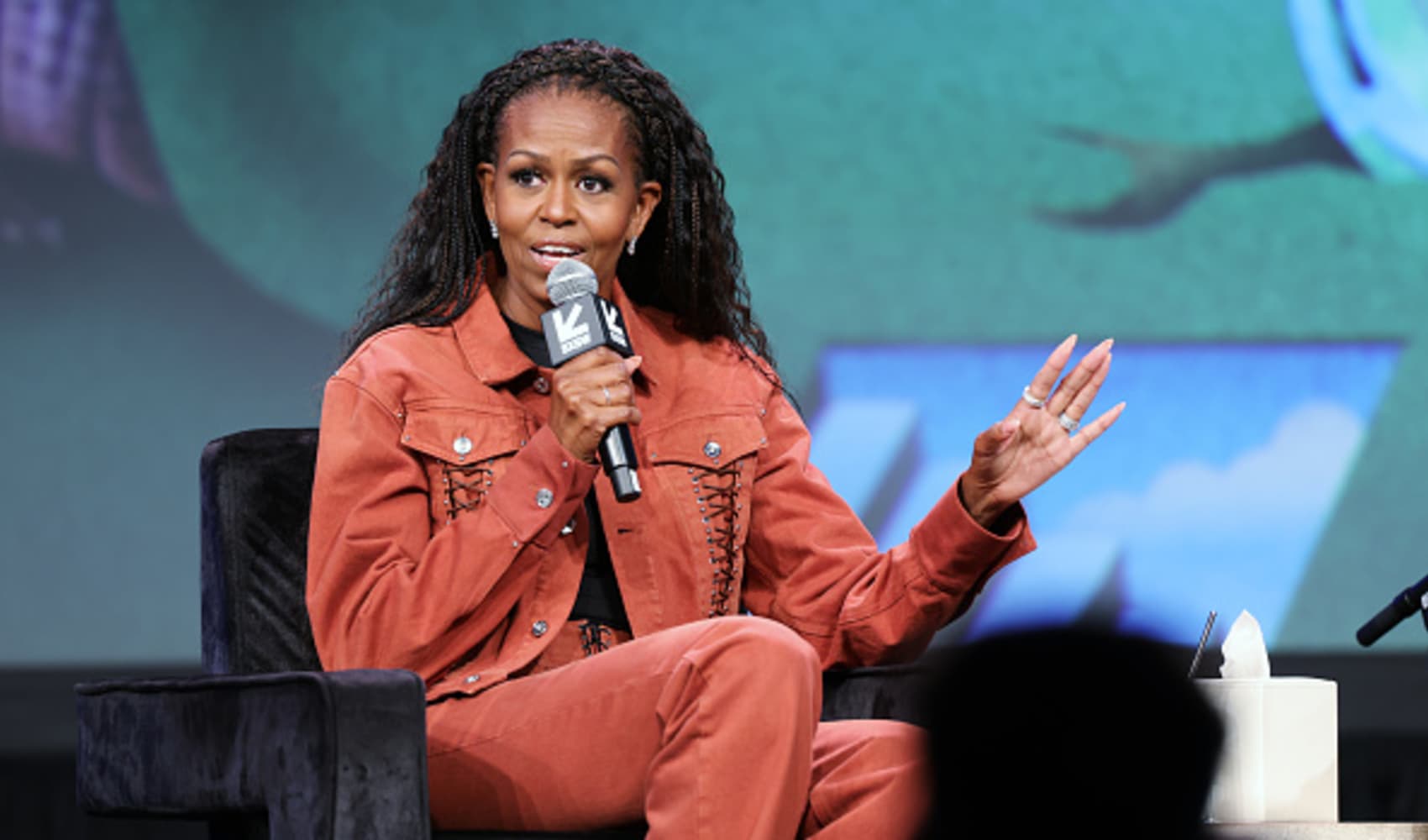Obama Daughters' Tabloid Nightmare: Michelle's Untold Story
Michelle Obama's "Nightmare": Protecting Daughters from the Tabloids
Introduction: The Price of Fame for the First Daughters
Imagine raising your kids under a microscope, every milestone dissected, every misstep magnified. That's the reality Michelle Obama faced while her husband, Barack Obama, served as President of the United States. Now, the former First Lady is opening up about the unique challenges of raising Malia and Sasha in the White House, particularly the uphill battle of keeping them out of the ever-watchful eye of the tabloids. It was, in her own words, a "nightmare." But why was it such a struggle, and what lengths did the Obamas go to protect their daughters?
Navigating Teenage Years Under the Spotlight
As Michelle Obama recently shared with Kelly Ripa on SiriusXM’s “Let’s Talk Off Camera,” keeping Malia and Sasha out of the tabloids was “a lot of work” that only intensified as they grew older. Think about it: puberty, first crushes, learning to drive – all already fraught with anxiety and awkwardness, but magnified a thousand times when every move is potentially headline news.
Normal Experiences, Abnormal Scrutiny
Michelle emphasized that Malia and Sasha, who were 10 and 7 when their father took office in 2008, deserved the chance to experience normal teenage milestones. "They had to drive and they had to go to prom and they were on teams and they traveled to other schools..." These seemingly mundane activities were actually battlegrounds in the fight for their privacy.
The Tightrope Walk of Parenthood in the Public Eye
Being a parent is hard enough, but add the pressure of representing an entire nation, and you’ve got a recipe for intense stress. The Obamas had to strike a delicate balance between allowing their daughters to grow and learn, while simultaneously shielding them from the potential pitfalls of fame.
The Constant Threat of Paparazzi
Imagine the constant anxiety of knowing that at any moment, a photographer could be lurking, ready to capture a compromising or unflattering image of your child. That’s the reality the Obamas faced daily. The relentless pursuit by paparazzi made even simple outings a logistical and emotional challenge.
The Power of Modeling Good Behavior
One crucial strategy the Obamas employed was modeling the behavior they wanted to see in their daughters. They consistently presented a united front, demonstrating respect, integrity, and a strong sense of family. This created a stable and supportive environment that helped Malia and Sasha navigate the pressures of their unique situation.
Leading by Example
The Obamas understood that their actions spoke louder than words. By consistently upholding high standards of conduct, they provided a positive example for their daughters to emulate. This helped to instill in them a strong moral compass and a sense of responsibility.
Building a Circle of Trust
Another essential element of the Obamas' strategy was surrounding their daughters with a trusted inner circle. This included family, friends, Secret Service agents, and White House staff who understood the importance of protecting their privacy.
The Importance of Discretion
Discretion was key. The Obamas relied on a network of individuals who were committed to keeping Malia and Sasha's lives as private as possible. This meant avoiding gossip, respecting boundaries, and understanding the potential consequences of their actions.
Controlling the Narrative: A Strategic Approach
The Obamas also understood the importance of controlling the narrative surrounding their daughters. This involved working with the media to ensure fair and accurate coverage, while also actively pushing back against sensationalism and speculation.
Proactive Communication
Rather than remaining silent, the Obamas proactively engaged with the media to share positive stories about Malia and Sasha. This helped to shape public perception and counteract negative portrayals. They carefully curated the information that was released, ensuring that it reflected their values and priorities.
The Impact on Malia and Sasha: How They Thrived
Despite the challenges, Malia and Sasha Obama have emerged as confident, intelligent, and well-adjusted young women. Their success is a testament to the Obamas' unwavering commitment to their well-being.
Resilience and Grace Under Pressure
Malia and Sasha have demonstrated remarkable resilience and grace in the face of extraordinary circumstances. They have learned to navigate the pressures of fame with poise and maturity, while remaining grounded and true to themselves.
Lessons Learned: A Blueprint for Raising Children in the Public Eye
The Obamas' experience offers valuable lessons for anyone raising children in the public eye. Their strategic approach, unwavering commitment to privacy, and focus on creating a supportive environment provide a blueprint for navigating the unique challenges of fame.
Prioritizing Privacy Above All Else
Perhaps the most important lesson is the importance of prioritizing privacy. The Obamas understood that their daughters' well-being depended on their ability to shield them from the relentless scrutiny of the media. This meant making difficult choices and consistently pushing back against intrusions on their privacy.
The Enduring Legacy: A Family First
Ultimately, the Obamas' greatest achievement may be the enduring legacy they have created as a family. Despite the pressures of the presidency, they remained deeply committed to each other, prioritizing their relationships and creating a loving and supportive home environment.
Love and Support as a Foundation
Their story underscores the fundamental truth that love and support are the most important ingredients in raising happy and healthy children, regardless of their circumstances. The Obamas' example reminds us that even in the midst of extraordinary challenges, it is possible to prioritize family and create a lasting legacy of love and integrity.
The "Nightmare" Ends: Daughters Flourishing on Their Own Terms
Malia and Sasha are now adults, forging their own paths and making their own choices. While the "nightmare" of protecting them from the tabloids might be over, the legacy of strong parenting and unwavering support continues to shape their lives. They are living proof that even under the brightest of spotlights, children can thrive when nurtured and protected.
Conclusion: A Testament to Parental Love and Sacrifice
Michelle Obama's candid reflections on the challenges of raising Malia and Sasha in the White House offer a rare glimpse into the intense pressures faced by First Families. The Obamas' unwavering commitment to protecting their daughters' privacy, modeling good behavior, and building a strong circle of trust provides a powerful example of parental love and sacrifice. Their story is a testament to the enduring importance of family, even in the face of extraordinary circumstances.
Frequently Asked Questions
- How did the Secret Service help protect Malia and Sasha's privacy?
The Secret Service played a crucial role in shielding the Obama daughters from unwanted attention. They provided security and maintained a discreet presence, helping to manage crowds and prevent unauthorized access. They also worked closely with the media to ensure responsible reporting.
- What specific strategies did Michelle Obama use to help her daughters navigate social media?
While details are limited to protect the girls' privacy, Michelle Obama likely emphasized responsible online behavior, the importance of critical thinking when consuming information, and the potential consequences of sharing personal information. She may have also encouraged them to limit their social media exposure and to prioritize real-life connections.
- How did the Obamas balance giving their daughters a "normal" life with the security protocols required as First Daughters?
This was a constant balancing act. They prioritized activities that allowed Malia and Sasha to interact with their peers and experience everyday life, such as school events, sports, and social gatherings. However, these activities always required careful planning and coordination with the Secret Service to ensure their safety and security.
- Did Malia and Sasha ever express resentment about the lack of privacy they experienced?
While neither Malia nor Sasha have publicly discussed the challenges of their childhoods in detail, it's reasonable to assume that they experienced moments of frustration and resentment. The Obamas likely addressed these feelings with empathy and understanding, emphasizing the importance of their role in public service while acknowledging the sacrifices they were making.
- What advice would Michelle Obama give to other parents raising children in the public eye?
<
Based on her experience, Michelle Obama would likely advise prioritizing privacy, building a strong support system, modeling positive behavior, and actively engaging with the media to shape the narrative. Above all, she would emphasize the importance of fostering a loving and supportive environment that allows children to thrive, regardless of the circumstances.

